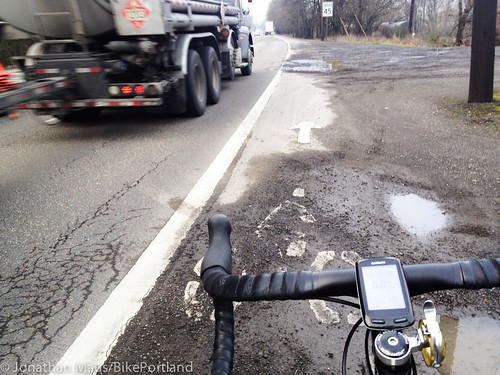
(Photos by J. Maus/BikePortland)
On the official City of Portland bike map, NW St. Helens Road/Highway 30 looks like a nice solid bike lane (see below). It’s the only north-south bike lane on the west side of the Willamette River between northwest Portland and Sauvie Island (and beyond). As such, this bike lane is an important route for many people — whether they’re commuting to St. Johns or using it as a gateway to many popular riding destinations.
Unfortunately it’s usually full of dirt, gravel, and other debris. It’s so bad that I recently learned in some circles it’s known as “Dirty 30”.
“Our street cleaning crews strive to serve all road users. That said, people using some modes of transportation experience roadway debris differently than other users.”
— Dylan Rivera, PBOT Communications Manager
When I posted some photos of this bike lane on Flickr recently, I got a comment from someone who said her experience on Highway 30 was so bad that it influenced her entire perception of Portland’s bike-ability:
“This exact “bike lane” is one of 3 or 4 main deciding factors in my decision not to move to Portland after 3 reconnaissance missions. I got so scared out of my mind on this bike lane that I ended up running up into the hills on my bad ankle to avoid having to complete my ride to Sauvie Island with huge trucks literally grazing my elbows at 55mph. I felt so trapped with no way to escape on foot or with my bike. Horrible… I found this and Barbur Blvd to be completely unforgivable of Portland and PBOT/ODOT. Utter insanity.”
Making matters worse is that it’s just a standard 5-6 foot bike lane (narrower in some spots, wider in others) and it’s adjacent to heavy auto and large truck traffic traveling at 50-plus miles an hour. In other words, you’re forced to ride directly in the debris zone or you risk being run over. As I’ve been riding this road more in recent months, I’ve been shocked at how poorly maintained it is. After I got two flats in one week (and I rarely flat), I decided to inquire with the authorities about who’s responsible for keeping it clean, why it’s so dirty, and what I can do about getting it swept.
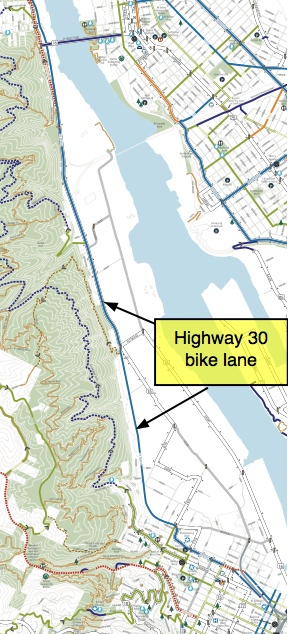
It turns out that the Portland Bureau of Transportation and the Oregon Department of Transportation share the maintenance responsibilities. PBOT crews have jurisdiction from I-405 to Linnton (8 miles north of downtown Portland) and ODOT crews are in charge from Linnton to milepost 18.
I asked ODOT spokesman Don Hamilton about their sweeping schedule and methods. He says they sweep Highway 30 “on average… every three months or so.” The traveling public can report bad conditions directly to ODOT by calling 888-275-6368 (AskODOT hotline) or the district maintenance office at 971-673-6200. “Both are effective for registering a problem,” Hamilton says, “and both will get right on it if something more serious is going on.”
As for the City of Portland’s section, which in my experience is in much worse shape than the ODOT-controlled section, PBOT Communications Manager Dylan Rivera says they “typically sweep arterial streets four to six times per year.”
Like Hamilton, Rivera said they also respond to citizen requests and he urged folks to call 503-823-1700 to report problems.
One of the big issues on Highway 30 is that there are several long sections where the roadway has no curb and the bike lane is adjacent to gravel and dirt driveways where trucks pull out, leaving a trail of debris in their wake. In researching this article, I learned that the City of Portland has a specific policy to not sweep these “uncurbed” streets. According to the City’s website, “uncurbed streets are, in effect, self-cleaning” because motorized vehicle traffic brushes it away.
Obviously, as you can see in the photos below, curb or no curb, the “self-cleaning” is more myth than reality…
Rivera made a point to tell us that street cleaning services were cut back “significantly” during the recession” and that PBOT has had to prioritize sweeping based on citizen reports and on streets, “where the public need is the greatest.”
About the gravel-filled bike lanes on uncurbed sections of Highway 30, Rivera said they’re well aware of that issue due to one persistent citizen activist. “There is one cyclist who apparently calls every two weeks to request sweeping on Hwy 30. We have explained to him that cars and trucks pull out into the highway from unimproved parking lots along this route, spitting gravel into the bike lane over time. While we certainly try to keep the area free from debris, we do not have the resources to keep the area spotless. Other than this gentleman, we have only had 2 requests to remove debris from this area in the past 12 months.”
It seems, for now at least, people who use a bicycle to travel on Highway 30 will simply have to deal with these dangerous and dirty conditions. When I shared my perspective with Rivera that it seems people on bicycles suffer a much greater impact from the City’s current sweeping policy than people who drive a car or truck, he replied by saying, “Our street cleaning crews strive to serve all road users. That said, people using some modes of transportation experience roadway debris differently than other users.”
That’s the understatement of the year.


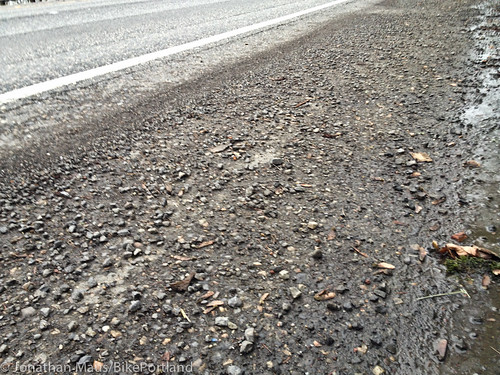

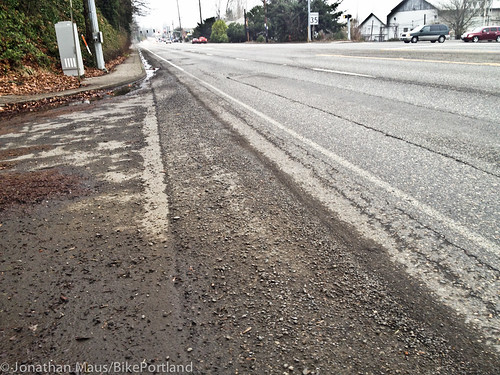
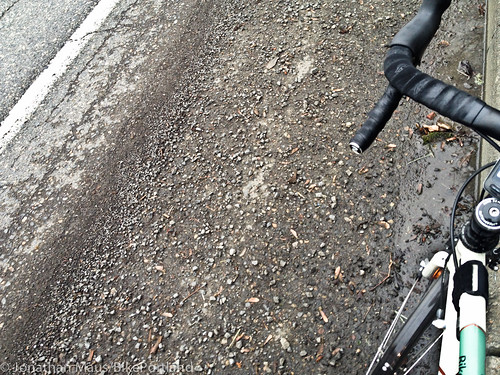


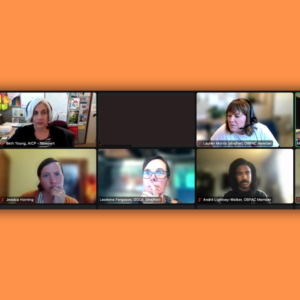
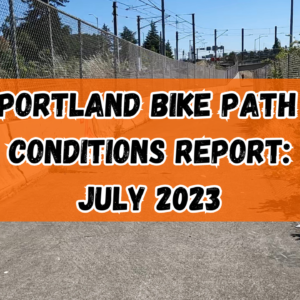
Thanks for reading.
BikePortland has served this community with independent community journalism since 2005. We rely on subscriptions from readers like you to survive. Your financial support is vital in keeping this valuable resource alive and well.
Please subscribe today to strengthen and expand our work.
I first heard “dirty 30” back in 2006 when i first started riding for fitness out to sauvie from downtown
i was led to believe its meaning was not so much for gravel as for other tire stabbing detritus that may cause a short tire change by the side of the road
and i’m sure that phrase is a lot older than my introduction to it
Well, looks like we just need to start calling. All of us. Every month.
Yep. Squeaky bike wheel gets the street cleaned.
I had the same experience on my daily commute on Hwy 43 between Lake Oswego and the Sellwood Bridge. One day I finally got feed up and called ODOT to report the problem. Too may surprise, they sweep the shoulder of the road the very next day. Thanks ODOT.
so does this street sweeping request work on all streets in portland? usually Halsey, burnside, division, stark, pretty much all the east-west bike lane routes are pretty terrible this time of year. i wouldnt know because ive just stopped riding on them because of all the debris.
Oh Boy!! I call myself and those who ride this road daily, the “St. Helens Suicide Club”. It’s pure terror! I’ve had 2X4’s fly out of trucks on their way to the dump and almost hit me. I had a semi truck carrying a crane pass me with about 6 inches to spare.
Pretty sketchy and I think it’s a disservice to people to have this road on the biking map marked as a green route. Yes, technically it IS a separate lane, but no way in heck would I ever let any of my family ride that road. It’s WAY too dangerous!
” In researching this article, I learned that the City of Portland has a specific policy to not sweep these “uncurbed” streets. According to the City’s website, “uncurbed streets are, in effect, self-cleaning” because motorized vehicle traffic brushes it away. ”
Really? That seems like a pretty funny policy.
Also, is there some magic number of times to contact about sweeping?
One guy calls every two weeks or so, and that’s too much.
Then they had only two other requests in 12 months, so that’s not enough.
What is the correct amount of contact to actually get it done?
I know exactly where those photos were taken and agree that it’s always a mess there, at least in the summer months when I do Highway 30 workouts. I’ve thought about driving out there with a push broom, but have never gotten around to it. Guess I need to put that number in my address book and use it…not too frequently though.
I’ve ridden Dirty30 for years and the conditions have remained about the same throughout the years, sometimes surprisingly good/great, other times horrible. The winter is of course the worst. Last week we did a ride starting at Sauvie Island to the Scappoose dike roads, out Dutch Canyon and back in on 30. It was amazing how clean 30 was from Sauvie to Scappoose. There was almost no debris, no gravel whatsosever. It was so clean I think all 17 of us at one time or another during the ride made mention of it. From St Helens Rd out to Sauvie is another story altogether…
A few years ago I noticed on Sunday rides out to Sauvie there would always be a crew of either incarcerated juveniles or adults picking up trash on St Helens Rd and out 30 to the St Johns Bridge with a Sheriff escort. I saw them every Sunday. One Sunday I stopped and told the Sheriff about the cycling conditions on Dirty30 and ask if it would be possible for half the “prisoners” to pick-up trash and the other half to sweep the bike lane. She loved the idea and said most of the guys weren’t picking up the trash anyway! The very next week she had probably 10 guys with brooms sweeping the bike lane and the rest doing trash!!!! For the next 4 to 6 weeks Dirty 30 was actually pretty clean and debris free…and then the guys or the “program” disappeared. How does the problem get fixed or at least get better? Local bike clubs donate funds to various boy scout troops and the troops use sweeping 30 as a civic project? Contact the director of homeless services and again, local clubs pool resources and donate or pay for a crew to sweep on a regular basis? Local bike clubs, teams and shops “adopt” portions of Dirty 30 from St Helens Rd out to the sauvie Bridge and once a month they agree to do a sweep job? One local business adopts Dirty 30 and arranges for the bike lane to get swept. The business gets an “adoption” sign somewhere along the road which “markets” their goodwill? Lastly, every single cyclist who reads this article sets the that city phone number on fire with complaints: 503-823-1700.
Not just Hwy 30, but have others noticed how much of the current PDX bikeway system everywhere is a debris field now? Try the Skidmore bridge overpass; the Cully bikeway. Virtually unrideable asteroid belts at present. Some areas are long streams of broken glass – like on Vaughn now. This just forces cyclists to ride further left into motor traffic than they otherwise would so it’s actually worse than having no bike lane at all. If bike lanes aren’t maintained, better not to have them. At least wayward auto traffic sort of ‘sweeps’ the streets edge while endangering cyclists 😉 I guess maintenance is reduced in winter, but a shame and certainty counter to considerable efforts persuading more casual cyclists to ride in the cold and/or wet months. Challenging enough for many, but the prospect of frequent puncture repair in cold, wet dark rides home is enough to dissuade even the committed.
Sounds like the real solution is for the ODOT, PBOT or property owners to “improve” the roads that feed onto HWY 30 – at least for say 20-30 feet that adjoins the roadway. This would help keep a bit of that sweep effect from happening.
The $20K question is: how is that made a requirement and made to happen?
The paved streets along 30 are just as horrible. I jump from Front to 30 via Nicholai, and have gotten so many flats in that part of my commute I’ve lost count. Rocks, Glass, Bricks, Lumber, Random hunks of metal embedded in the road surface. It’s Mad Max out there.
If I had to ride in that kind of crap on a regular basis, I think I’d invest in a set of Schwalbe Marathon Plus tires.
I have a love/hate relationship with the bike lane on this road. On one hand, it has big problems with debris and high speed traffic, but on the other hand it is long, flat road with minimal stoplights. It is ideal for time trial or interval training sessions. It is also the most direct route from St. Johns to downtown. Widening the bike lane where it is narrow and keeping it clean would help keep riders from getting stressed out.
Improvements that are sorely needed are better bike connections at the St. Johns bridge and Hwy. 30. Riding on Bridge Ave is worse than Hwy. 30 in my opinion.
The commenter who didn’t move here (yet), Earl Apricot, lives in Minneapolis. That fact right there means she will in fact be moving here. Well, maybe Seattle.
I’m currently living in Minneapolis temporarily after 8 years in SF, where I was hit by 3 cars and decided I’d had enough (the last one was a hit-and-run by a presumably-drunk driver that scared me witless and left me with permanent injuries). My plan is indeed to move to Seattle within a year or so. Seattle is by no means ideal. It has a long way to go just like every other U.S. city, but I was surprisingly *much* less stressed out while riding there, and there are completely separated trails from the center of the city that go far out into the metro area in several directions and even clear across the state. I chose it also largely because it’s much easier to live with no car there without sacrificing as much mobility as I’d have to sacrifice in Portland (at least some of Seattle’s transit runs all night). And car-free vacation options are endless. You can get to the islands, Portland, Victoria, Bellingham, Vancouver, and all points in between *with your bike* on trains and ferries. That and I happen to love biking on hills. So yeah, Seattle was the clear choice for me.
Also: Minneapolis has Portland beat for recreational distance riding on separated trails that run right through the center of the city and far into the suburbs and beyond in every direction. The trail network here is *amazing* for a major U.S. city. However, for every-day transportation riding, Minneapolis doesn’t hold a candle to Portland (yet). Drivers in Minneapolis are some of the most oblivious and entitled I’ve ever had the misfortune of “sharing” the road with. The winter riding, though, is not as awful as it seems, and it can be heaven on earth on a nice day (> 20F and sunny). For the most part, you just need the right clothes, but that means you have to spend half an hour gearing up like you’re preparing to be shot out of a cannon just to make the 15 minute commute to work. Yeah I’m looking forward to the PNW. Am I ever.
Most sweeping is done to comply with requirements for National Pollutant Discharge Elimination System (NPDES) permits. I doubt that the 4-6 times a year sweeping by Portland complies with the permit requirements. Cities usually have to sweep at least once a month. Something worth checking into.
There should be an email address to send a note to every time you decide against biking somewhere because you don’t want to deal with scary patches. Like “I was gonna go to a movie at the Bagdad but who wants to cross 84?”
Hashtag it? #bikepdxwoes
I just don’t bother riding any part of (modern) US 30 unless it’s an emergency or De Ronde PDX. I’ve done the route a few times and finished the event, so this year I’m thinking about taking Leif Erikson and joining up on Saltzman this year.
Historic 30 is still rad.
I moved back to Portland 1.5 years ago. I live in St Johns and work in the NW. I commuted using the 30 for several months, but I was getting flats at the rate of about 1 every other week. It became so intolerable that I was considering just giving up bike commuting, but then I switched to Willamette -> Greeley -> Broadway Bridge. It’s a longer route, and Greeley isn’t great, but my flats virtually disappeared. I did call and complain about the conditions of the bike lanes, but nothing changed; I’m guessing I’m one of those “two people”.
Ultimately, a protected path that follows the river (e.g. the planned North Portland Greenway) is what’s needed, whichever side of the river it’s on. I’d gladly go a few extra miles on the east side if there were a good route.
as your last two pictures show, and I’ve checked in the past, those aren’t really bike lanes because there’s only a 4″ stripe between you and traffic… that means you’re really only on a shoulder… an 8″ line denotes a bike lane… you’ll notice there are no bike lane markings in those areas either…
Exactly. The “bike lane” on 30 should actually be flagged as a mapping or traffic-engineering crime. Where are the bike lane police? It should not be legal to put a bike lane symbol on a strip of road that’s narrower than a standard bike lane or, as in some stretches of 30, narrower than a bike’s handlebars. Especially not along side 55mph truck traffic!
I’m the one quoted in the article – and when I was riding that stretch of 30, I decided it was clear that Portland just threw some bike lane symbols on a *shoulder* that was clearly not engineered as a bike lane and threw it on a map to run up their bike-lane-miles to win their place as America’s most bikable city – or to meet a quota they’d set for themselves. I felt like I found out that Portland had actually cheated and its reputation was all a sham.
i 100% agree with these accusations! when they do those “best bike city” things they just look at govt data of miles of lanes, amongst other things. if there were such a thing as a third party, non governmental body that certified bike lanes based on certain criteria (width, cleanliness, safety etc.) Portland would lose 75% of its “bike lanes” and its national cred. I once saw a flattened road kill squirrel UNDERNEATH one of those painted bike lane symbols. no joke. we ride on shoulders most of the time. only portland has the gaul to spray a bike dude on top of a dead squirrel and call it a bike lane.
#bikefear
Front Ave is a good option to avoid some of the worst of this. I just wish that the City would make a connection from Front Ave back to HWY 30 north of the rail bridge. From Google Maps, it looks like there is an existing waterfront path that could turn west just north of Siltronic, and meet up with HWY 30 just south of the St. John’s Bridge.
“uncurbed streets are, in effect, self-cleaning” because motorized vehicle traffic brushes it away.
You can see from the photos that the street is, self cleaning. All the debris gets pushed into the bike lane / onto the shoulder
That’s exactly what I thought. The “self cleaning” bit is true from a car-centric point of view. The current bike lane is what the automobile-centric designers would have called the shoulder.
It’s good and all to call those numbers, but if you want there to be a permanent record of your complaint, shouldn’t you email everything? Safe@portlandoregon.gov and askodot@odot.state.or.us ?
Comments on this, Jonathan or others?
Ted Buehler
Though I suppose it might get done faster if you call the departments directly rather than email the general bureau contact line…
Yes, e-mail is best. Even better would be a cc for those e-mails that would go to a web site so that everyone can see what has and has not been reported. Long term failures like 30 would start to stand out. Or, how about an app that would route the report to the right place based on your GPS location and issue type, and cc a web site? Track me down if you want to help make that happen.
I only ride US 30 once in a while, but I’m pretty appalled at bike lane conditions generally, beyond just a lack of sweeping. I’ve noticed:
* bike lane narrows to less than the legal minimum of 4′
* signposts encroach on bike lane.
* unpaved driveways are not paved with “skirts” adjacent to the highway, causing the bike lane to crumble away in some places and get covered with mud in others.
* driving lanes may be in excess of the legal maximum of 12′.
* speed limits not enforced.
* poor way finding signage coming into town at St Helen’s/Leon.
* “free right” turn from eastbound US 30 to eastbound St Helen’s is a death trap for bicyclists.
Most of these will be fixed if PBOT/ODOT get a polite letter with a photo of the unsafe condition and a request that it be repaired.
Anyone want to go out on a Sunday and take measurements and photos? How about mid-February? I’d be happy to host it through AROW and do some of the reporting.
Ted Buehler
Friday Jan.24.
Today the lanes were cleaned.
I urge everyone to get out there and use them for the next week or so while the riding is “nice” until they’re swept again in September. Or October. Or the next time there’s a Bike Portland article about it.
Also, whenever you see broken glass and debris, send in a safety hazard email to safe@portlandoregon.gov They will sweep if anyone requests it. If all of you who ride it make a complaint every two weeks (like one person already does for US30) it will rise up the priority chain. And then they won’t be able to say “we”‘be only had two other complaints all year”.
Also, you can ask that now that the recession is over, that they reassign your street from the “rarely swept” list to the “regularly swept” list.
And the “no sweeping uncurbed streets” is nuts, seems like this is a policy begging for change. Any thoughts from insiders/experienced PBOT hagglers on how to get this changed?
And,
actually maybe someone reading your article. i rode it yesterday to scapoose and it was swept clean. very surprising!
I have extensive experience on Hwy 30, commuting to St. Helens from NE Portland. The stated facts of high volume high speed traffic, variable lane size, lack of regular maintenance and poor conditions are indisputable. Fixing any of these will as KRhea said, take multiple resources and repeated input from our community.
I no longer need to ride from SJ to NW Yeon. For that, I am thankful. The presence of the Metro Waste Transfer Station and the abundance of metal recyclers add an additional burden to the amount of tire shredding debris on the roadway. Even with Kevlar and slimeliners, I still experienced flats.
Oh come on…aren’t gravel bikes all the rage right now?????
It’s mearly PDOT and ODOT’s way of pushing sales of $3000.00+ mountian bikes with drop bars, or a road bikes with mountian bike tires – depends on the one you’re looking at I guess.
Full disclosure. I haven’t read this article yet but the first sentence made me laugh out loud. Nice solid bike lane…omg. Ok I’ll continue reading now.
Ok, I read on a bit. I love how the quote compares dirty 30 to the POS Barber…..totally agree. By the way I stopped riding Barber completely. Now back to the article.
That second from bottom picture, swept or not, any of you who ride that regularly (as in, more than once!) get my admiration as a Geller “strong and fearless” 1-percenter, and I hope you get a better route soon.
OMG. This is good news coverage on a part of Portland that deserves more love. I haven’t ridden it for a while, but I’m sure I will be out there this summer…ugh…what a POS….maybe I should consider other options. Seriously this is as bad a Barber and I gave that up. I should completely give this up too.
Imagine if you got a flat in your car every couple of weeks on your commute. That road wouldn’t be considered acceptable.
My wife and I ride our Co-Motion Java tandem from the intersection of Front St & US 30 out to Scappose or St. Helens roughly once a month. On our last outing (12-16-13) the gravel density on the bike lane was horrid! We run 700x28c tires at 30# over maximum recommended pressure (bike tire manufacturers usually test their tires on hooked bead rims to 150% of the listed maximum pressure) and at times had to ride at the edge of the traffic lane on our left. We DO run a very bright blinking red light attached to the end of our rear rack and have yet to be passed closer than two feet along that corridor.
Guess I haven’t ridden it lately, but from 2000-2003 I rode Hwy 30 to very-outer NW Portland every day. I actually had worse problems with glass and sharp metallic debris on Front (now Naito) Avenue than I did on 30, which I also rode a number of times to Sauvie Island and Scappoose/St. Helens, though the latter rides may have been after spring sweeping.
I don’t remember it ever being that bad. Maybe it’s worse now. To me the adjective “horrible” is reserved for situations where other vehicles are putting me in danger, which I don’t feel on most of Hwy 30 because in most places the shoulder is really wide. I guess as long as there isn’t a bunch of glass, I don’t mind a bit of gravel.
But then I don’t ride on ultra-thin, ultra-skinny tires and expect the roads to conform to the needs of a racing machine. (And no you don’t need an expensive new gravel bike – any touring or cyclocross rig is capable of running cyclocross tires that can handle gravel and moderate levels of glass shards with aplomb. My experience is that a 130psi racing tire is only marginally faster than a good ‘cross semislick at 90psi. Enough to matter in a race, but not on a recreational ride unless you’re really hyper-competitive).
I’m the one quoted in the article and my sentiments were much more about the width of the lane next to such high speed traffic than they were about the condition of the surface (though I did notice that was a big problem at points too). I’m not sure where this “wide shoulder” is you’re talking about because the part I rode on (between the city and St Johns Bridge) featured a frequently disappearing shoulder that was very often *much* skinnier than 4ft (not that 4ft unbuffered is adequate next to high speed truck traffic like that). For example, I would describe this as “horrible”, and this was nowhere near the worst of it – this is just where I finally found a place I could dismount and escape:
http://www.flickr.com/photos/earlapricot/8036092706/
I got the feeling while I was there that Portlanders have a very different idea of what a wide shoulder is, as at least one Portlander described the shoulder on Terwilliger to me as “generous”, whereas that’s not how I felt about it at all when I rode on it. (It wasn’t terrifying, but it wasn’t “generous” by any stretch, especially when it was filled with debris.) I came to think that Portland’s bicyclists have just been short-changed on separation from high-speed traffic for so long that they’ve become desensitized. But as someone who has been hit from behind by a car before – a car I never even saw coming – and I never saw it leaving either – I will forever be quite sensitive to how close I’m forced to ride next to speeding traffic. That said, I don’t think someone has to be suffering from PTSD to find this section of 30 completely insufferable on a bike. As a former bold-and-fearless rider who is now perhaps more on the interested-but-concerned end of the spectrum, I can say this section of road is *not* up to the standard of Portland’s reputation and will never convert new riders. And in this case, it helped convince an interested-but-concerned rider not to even move to Portland. Too many lanes are too skinny for the speed of the traffic they are adjacent to.
that picture is a perfect illustration of how people die on bicycles
OT: that is a cool bell on your headset. where can I get one?
Hi Bill G.
Glad you noticed. It is an awesome bell. It’s the Alexander Graham model from Portland Design Works. https://www.ridepdw.com/goods/cockpit/alexander-graham
I am working up a full review soon.
So–all that gravel comes from somewhere. In this case, it seems that the driveways of the adjacent businesses is the source. Doesn’t it make sense for them to have some responsibility for it?
Maybe the action item from this post is to un-designate 30 as a bike route. It certainly doesn’t deserve the bold green line it gets today on Google maps.
30 from NW Vaughn, all the way to the St. John’s hook-up is a joke, as pretty much anybody who has ridden it will agree. I go through NE and cross the bridge every time I wanna go out to Sauvie Island. A few rare times I’ve forgotten and been in the midst of this joke of a bike lane and ended up hating myself for it. It’s still fairly nasty once you pass the Bridge, but it’s wider and safer and your main problem is gonna be punctures. That’s my advice for people who are getting into cycling and wanna go out towards the island. Use the bridge and you’ll be doing yourself a huge favor.
I’m the commenter quoted in the article. I wish I’d have known this alternate route when I was visiting. However, as I was based in NW during my stay, that would have been a pretty indirect way to go. Where I eventually dismounted and escaped was right by St Jonh’s Bridge. What I could see with my eyes from there looked to be more of the same, so I escaped while I could. I kept waiting for it to get better, but by St John’s Bridge, I decided I couldn’t wait any longer for conditions to improve. I had to flea.
‘…people using some modes of transportation experience roadway debris differently than other users.’ Good Lord, alert the authorities, I think Dylan is on to something here…
A number of years back I rode out in the rain to a job interview not even too far out highway 30. Was very clean when I left home. Even applying for a messenger job, I had gotten so dirty on the ride out 30 that they commented on it directly, and questioned my ability to look presentable for work…
Love that lead photo… going should-to-shoulder in a puny bike lane with massive freight rigs on a posted 45 MPH zone–which means they’re often doing 50+.
During last year’s Disaster Relief Trials, Highyway 30 was, for me, the worst segment of the entire route. At one stretch where the narrow bike lane was hemmed in on the right by a guardrail, a fast-hauling freight truck loomed behind me, encroaching the bike lane stripe. Lucky for me I looked back in time to see it encroaching, forcing me suddenly to the right where I ground hard against the guardrail, moderately damaging the bike. Lucky, also, that the impact didn’t glance me back into the path of the truck.
I won’t ride Highway 30 again.
That stuff is slick to crazy to ride in. but hey its only lane we got makes ya wonder who causes most damage.
Don’t forget the cars parked in the bike lane in lint on! Or is it even a bike lane there? I can never tell.
ODOT won’t do the job of sweeping the bike lanes on state roads, and they won’t turn the job over to the Cities to do so.
For instance, I tried and tried to get someone, ANYONE, to come out and sweep the large chunks of glass (the size of my thumbnail), and shards of ceramic bowl (some as large as my foot, and curved so it’s obvious what it is) off the bike lanes on Hall Blvd in Tigard.
I emailed Basil Christopher, Vance with City of Tigard, and the general ODOT email to see if I could get some action. The guy ODOT sent out to look it over and make an assessment, Curtis, claimed he didn’t find anything at all– that the glass I was seeing were the beads they use in striping for reflectivity, and that he couldn’t find any ceramic shards. Well, I have two chunks of glass that look like large multi-carat diamonds, and that seems to be a terrible thing to use for reflectivity. I also picked up several pieces of ceramic bowl. I’ve still got the pictures, too, that I sent out to everyone involved and ODOT still refused to come out and sweep.
I got tired of arguing with Curtis, so I pushed it all out of the bike lane as best as I could.
Bottom line: It’s not just Hwy 30 that ODOT makes excuses for.
Someone should investigate if the sweeper truck drivers actually do the job that they get paid for! I’ve seen them sitting doing nothing late at night many times when they should sweeping.
Sweeping is just part of the problem on Hwy 30.
Coming from downtown or NW, It’s absolutely dangerous for cyclists going northwest on Hwy 30, who are trying to get onto the St. John’s Bridge. Rarely is traffic at a point that one can merge safely. You either sit there forever until that opening occurs, or, you just go for it, risking your life at the same time.
Definitely not a road or ride for novice cyclists.